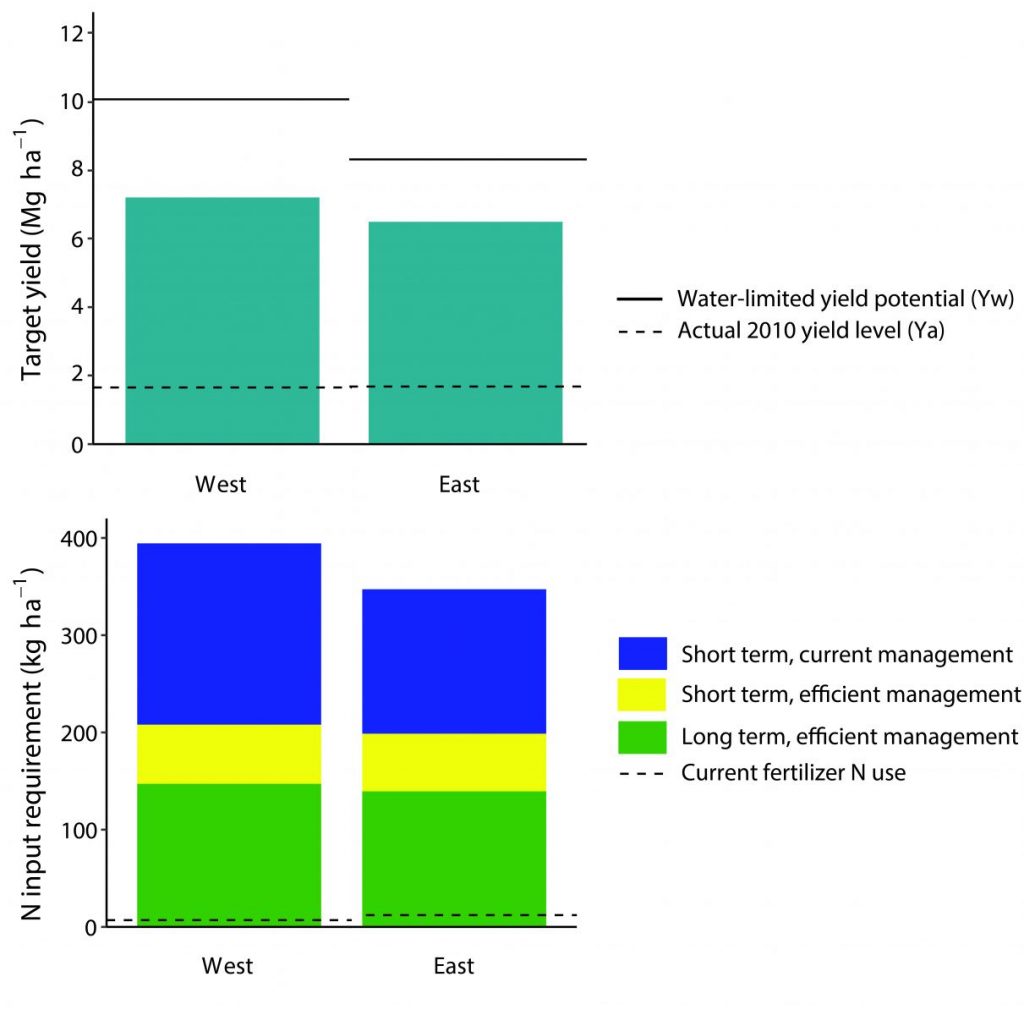
Maize productivity must increase four-fold to meet growing demand in Africa; implications for low emissions development?
By Hein ten Berge and Martin van Ittersum (Wageningen University & Research)

Demand for maize, a staple crop in sub-Saharan Africa, is growing. Can the region achieve self-sufficient production without converting natural lands to cropland? Photo: CCAFS
Steep population growth and changing dietary preferences will quadruple maize demand in sub-Saharan Africa. Can production keep up? At what cost to climate change?
Using data from Burkina Faso, Ghana, Mali and Nigeria in West Africa and from Ethiopia, Kenya, Tanzania, Uganda and Zambia in East Africa, our research shows that average production of 1.7 t/ha of maize in 2010 must increase to 6.8 t/ha to meet estimated demand in 2050.
To achieve this, per-hectare maize output must grow by about 3.5% per year, a rate never witnessed at national or supra-national scales anywhere in the world in rainfed agriculture.
Corresponding nutrient inputs must grow by over 7% annually to prevent further soil depletion and degradation.
Are such yield increases possible?
Our answer is a resounding yes. Using the Global Yield Gap Atlas, we calculated an average rainfed yield ceiling of 9.2 t/ha for maize across the nine countries, with area-weighted country averages ranging from 6 t/ha in Tanzania to over 12 t/ha in Ethiopia.
On average, current maize yields are 20% of rainfed potential. They need to increase to 75% of rainfed potential to achieve regional self-sufficiency by 2050.
In one of our scenarios, we presume that countries trade maize within West or East Africa; and that maize would replace other cereals in the diet in cases where production of those cereals cannot meet consumers’ demand, as shown in the figure below. Management of maize will need to radically increase in efficiency.

Scenario in which maize target yields and corresponding nitrogen input requirements meet self-sufficiency in 2050 for West Afica and East Africa. (Adapted from Figure 4 in ten Berge et al.)
Target yields and corresponding minimum nutrient input requirements
Conventional maize production techniques in much of the nine countries rapidly deplete soil nutrients. Future food demands will aggravate this. Even sustaining 2010 average yields into the future will require at least three times more nitrogen (N) and phosphorus (P) input than is currently used, according to statistics from FAO. Current average potassium inputs are negligible, and must increase steeply to avoid future soil depletion.
Figure 4 in the article, simplified above, summarizes target yields for West and East Africa and corresponding N input requirements. Required N input varies according to the level of N use efficiency. If farmers minimize N losses and manage crop, soil, and nutrients to build soil fertility over the years, in the long they will need only the ‘minimum N requirement’ (shown in green). This presumes a high N use efficiency of about 50 kg grain per kg N input. Failing to build up soil fertility will increase annual input requirements (in yellow). Today, however, N use efficiency is very low at only 14 kg grain per kg N input. At this level, even higher inputs would be required (in blue), but it remains very doubtful that the high target yields can be attained without drastic improvements of today’s soil and crop management. Hence, under current management, such high N rates should be regarded as wasteful.
Trade-offs with greenhouse gas emissions
We all know that over-use of nitrogen fertilizer costs farmers money and causes environmental problems, including greenhouse gas emissions and water pollution. This is not the case in sub-Saharan Africa, where insufficient use of agricultural inputs causes poor yields, loss of soil fertility and consequent soil degradation.
In sub-Saharan Africa, increased use of nitrogen fertilizer is associated with meeting sustainable development goalsto end poverty and hunger.
Our goal is to identify optimal nutrient and fertilizer requirements. We also aspire to improve integrated soil fertility management to realize productivity gains while minimizing greenhouse gas emissions and other negative environmental impacts.
Without investment in soil fertility, existing croplands will degrade further. This will increase pressure to convert natural lands to croplands, at the expense of the immense carbon stocks and biodiversity value in natural lands.
We are now analyzing the impacts of increased nutrient use on greenhouse gas emissions. Then we will compare these with emissions associated with conversion of forests and grasslands into croplands.
Time to act and to scale
Farmers cannot achieve such ambitious productivity increases alone. They require supportive national and regional policies that enable cost-effective integrated soil fertility management. For example, improved physical infrastructure and financial mechanisms are necessary to ensure widespread availability and affordability of farm inputs. Government, development agencies and private sector agricultural extension efforts must intensify support for crop and soil management and associated risk management. Their action should span from planting (adapted genotypes, sanitized seed, timely soil preparation, and proper seed rate) to healthy growth (weed control and protection from pests and diseases) to harvest and post-harvest technology. But they also need to tackle grain storage facilities that prevent waste or farmers being forced to sell at rock bottom prices.
The Global Yield Gap Atlas contains maps and data assessing yield potential for different crops using local weather and soils data and locally validated crop growth models. The resources and methods described in our paper can be applied to other countries to help refine yield targets and nutrient requirements for several key crops. Likewise, instead of relying on extrapolations, scientists can use the explicit mechanisms and assumptions available in Global Yield Gap Atlas to improve integrated assessment studies (using models such as IMPACT, IMAGE, etc.)
Read more:
- Journal article: Maize crop nutrient input requirements for food security in sub-Saharan Africa
- Data and maps: Global Yield Gap Atlas
This article originally appeared at www.ccafs.org
